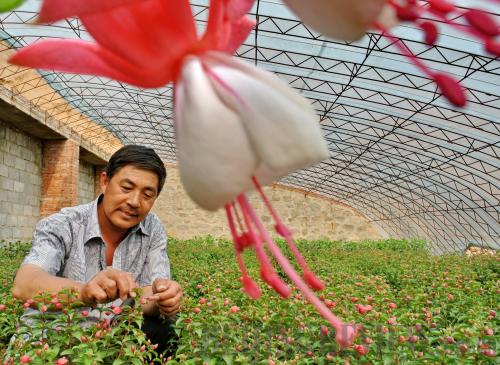|
 |
|
GROWTH BLOSSOMS: Liu Shuyong, a farmer of Xingshuyuan Village of Changli County, Hebei Province, clips flowers at his greenhouse (YANG SHIYAO) |
Europe and the United States are China's major export destinations. However, due to the sovereign debt crisis, demand from these two major markets continues waning. Figures from the Ministry of Industry and Information Technology showed that in the first five months of this year, textile exports to the EU dropped by 11.2 percent.
Some policies have also weakened the internal impetus of the Chinese economy. For example, growth of investment in real estate development has been in decline due to tight control, sluggish sales and reduced source of capital. Moreover, because of the government-led economic restructuring—curbing investment in industries of high energy consumption, high pollution and surplus production capacity—industrial investment is also declining.
According to NBS figures, in the first half of this year, fixed-asset investment rose by 20.4 percent, a decline of 5.2 percentage points from last year.
The real economy is hence affected. In the first half, the average daily power generation, rolled steel output and crude oil processing saw sharp declines, indicating the lackluster prospects for business operations of enterprises. In June, the purchasing managers index (PMI) stood at 50.2 percent, 0.2 percentage points lower than that of previous month.
Liu Yuanchun, Vice Dean of the School of Economics of Renmin University of China, said the latest economic slowdown is mainly caused by external factors. "Under the background of globalization, world economy deeply affects the Chinese economy," Liu said.
Effective measures
Lian Ping, chief economist at the Bank of Communications, said with recent government measures, both external and domestic demands have started to recover since May, and economic growth is expected to pick up in the third quarter.
Policies promoting investments are producing results. In late May, the National Development and Reform Commission approved a number of major investment projects. With implementation of these projects, growth of fixed-asset investment is expected to pick up in the third quarter.
Bank of Communications' report said year-on-year growth of retail sales of consumer goods had been in decline since the end of last year, dropping from 17 percent to 14.5 percent in May. But with real estate transactions on the rise and subsidies to energy-saving home appliances being implemented en masse, consumption growth begins to pick up.
| 